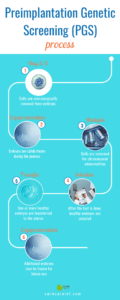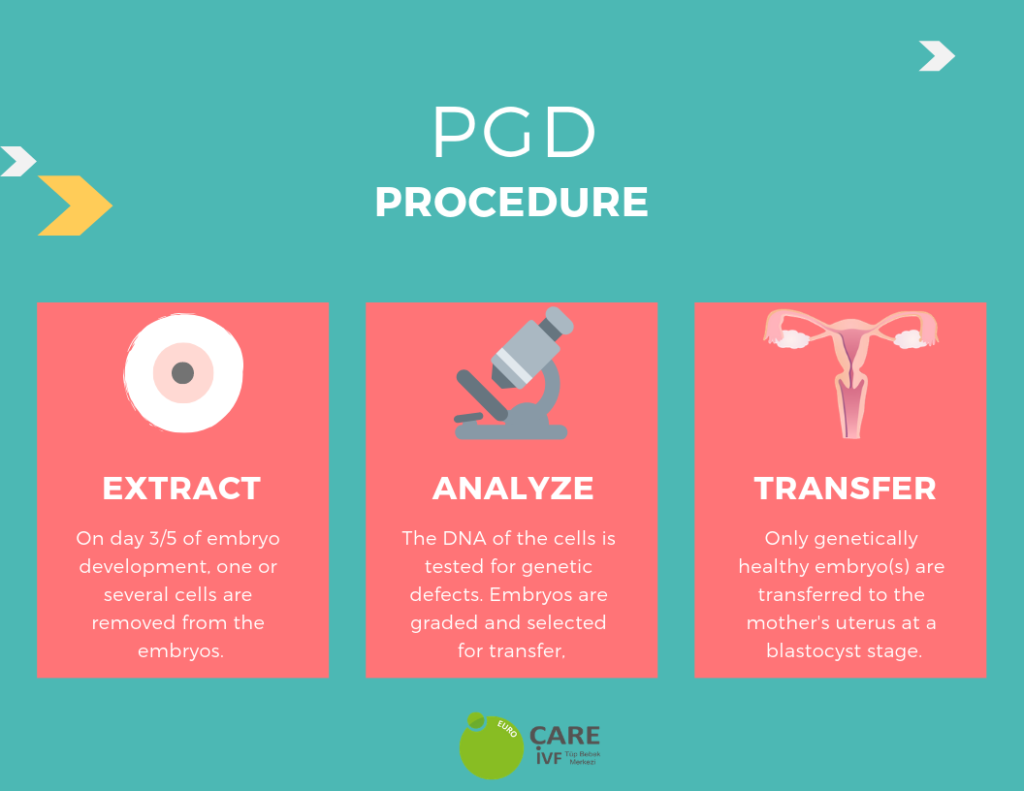 Genetic Screening techniques are the technological advancements that changed in vitro fertilization (IVF). The techniques examine the genetic structure of the embryos and detect a number of abnormalities.
Genetic Screening techniques are the technological advancements that changed in vitro fertilization (IVF). The techniques examine the genetic structure of the embryos and detect a number of abnormalities.
When combined with IVF, they decrease the risk of miscarriage and increase the chance of pregnancy success.
PGS (Preimplantation Genetic Screening) and PGD (Preimplantation Genetic Diagnosis) Cyprus are genetic tests that have made IVF most successful than ever! Assisted reproductive treatments can now address infertility and genetic conditions more effectively than before. Couples and individuals affected by a genetic disorder have the possibility to conceive a biological child.
PGS and PGD are sometimes used interchangeably. They are two different tests used in conjunction with IVF.
What is PGS Testing?
PGS (Preimplantation Genetic Screening) is a genetic test that screens embryos for chromosomal abnormalities (aneuploidy).
Aneuploidy is the condition in which an embryo contains one more or one less chromosome. As a result, there are 45 or 47 chromosomes present instead of the normal 46. Numerous studies showed that a high proportion of human eggs is affected by aneuploidy. The phenomenon is linked to female age. In women over 40, half of the eggs retrieved in IVF will be chromosomally abnormal. Embryos are also affected by the male factor. The rate of aneuploidy in normal sperm is 6-7%. In cases of severe azoospermia, it can reach a higher level.
Aneuploid embryos lead to miscarriage, failed IVF cycles and birth defects. In fact, 80% of all miscarriages are caused by chromosomal abnormalities in embryos. Implantation failures too may be a result of growth arrest or degeneration of defective embryos.
The high frequency of aneuploid embryos and the negative outcomes associated with their transfer in IVF cycles have led to the conclusion that only normal embryos should be transferred.
PGS evaluates the chromosomal composition of embryos and assesses their quality. Only embryos that are chromosomally normal (euploid) will be transferred to the mother’s uterus. Studies showed that PGS carried out on day 5 and 6 of embryo development can result in pregnancy rates >75%.
Who benefits from PGS?
PGS is generally recommended to:
- Women after the age of 35;
- Women who have had a miscarriage;
- Women with multiple failed IVF cycles;
- Azoospermic men;
- Women with a previous pregnancy affected by aneuploidy;
- Couples who wish a baby of a particular gender.
How does PGS testing work?
On day 3 or day 5 of embryo development, the embryologist will remove a few cells from the embryos in IVF. The DNA of these cells will be analyzed for chromosomal defects. The embryos will be graded based on quality. Only the best embryo(s) will be selected for transfer. At this stage, the embryologist can determine the gender (sex) of the embryos. If parents are interested in family balancing, then only embryos of the desired sex will be transferred to the mother’s uterus.
This is an overview of the PGS testing process:

Benefits of PGS Testing
PGS test detects chromosomal abnormalities in embryos that can results in genetic diseases during life. These are muscular dystrophy, sickle cell anemia, cystic fibrosis and Tay-Sachs. PGS can also detect genetic conditions such as Trisomy 21 (Down syndrome) and Trisomy 18 (Edwards syndrome).
Does PGS improve IVF success?
Most of the failures in IVF are due to poor egg quality. In IVF, poor egg quality is associated with lower success rates and implantation failures.
PGS tests are >97% accurate. Success rates of IVF with PGS can go up to 70%. One study found that PGS can reduce the risk of miscarriage in women over 40 by up to 45.5%.
Disadvantages of PGS Testing
One chief limitation of PGS is mosaicism within the developing embryos. Mosaicism is the condition where different cells in an embryo have different numbers or arrangements of chromosomes. On average, about 50% of embryos at the cleavage stage have mosaicism. This is the reason why some fertility clinics carry out the test at the blastocyst stage. Mosaicism is significantly lower in blastocyst embryos. According to statistics, the rate of misdiagnosis for PGS is approximately 5% per embryo.
What is PGD Testing?
PGD is a genetic test performed on embryos when there is a known or suspected genetic disorder. PGD is one of the best techniques to prevent genetic conditions from being passed onto the child. The ultimate goal of genetic diagnosis is to select the best embryo(s) for transfer.
Who benefits from PGD?
PGD is generally recommended to:
- Women over 35
- Carriers of gender-related genetic disorders
- Carriers of single gene defects
- Women affected by chromosomal disorders
- Women who have recurrent miscarriages
How is PGD done?
The PGD procedure starts by removing several cells from the embryos on day 3/5 after fertilization. The DNA of these cells is then screened for defective genes. The process can take a few weeks. Once the results are available, only the genetically healthy embryos will be transferred to the mother’s uterus.

PGD Benefits
PGD is an alternative test for prenatal diagnostic testing. Couples avoid the distress of a late diagnosis in an already established pregnancy.
Moreover, PGD offers an alternative to pregnancy termination in case a genetic disorder was found present in the embryo. The advantage of PGD is that it is performed before embryo transfer.
Finally, couples affected by a genetic condition can have a biological child. Intended parents with a genetic disorder can avoid adoption, embryo donation, surrogacy, or giving up a child. PGD now allows these couples to have a baby unaffected by genetic anomalies.
How accurate is PGD Testing?
PGD approaches 100% accuracy. Due to chromosomal mosaicism in embryos, only in a few cases, PGD generates an incorrect diagnosis. However, IVF centers have optimized the PGD results by conducting the test at the blastocyst stage of embryo development.
What does PGD test for?
More than 400 genetic disorders are detectable with PGD. Some of the most common genetic conditions found in embryos are:
- Cystic fibrosis
- Tay-Sachs disease
- Spinal muscular atrophy (SMA)
- Hemophilia
- Sickle cell disease
- Duchenne’s muscular dystrophy
- Thalassemia
PGD is also a feasible option for parents who have hereditary breast cancer. Women who are affected by the genes BRCA1 and BRCA2 have a 60% – 80% chance of developing breast cancer. PGD can detect these genes early on and prevent them from being passed onto the offspring.
PGD Disadvantages
One long study suggested that the risks associated with PGD were the same as for IVF. These included low birth weight, premature birth, miscarriage and ectopic pregnancy.
The test cannot completely eliminate the risk of developing a genetic disorder during life. Some genetic disorders and diseases generate symptoms when affected individuals reach middle age.
Furthermore, PGD cannot substitute for prenatal testing during pregnancy. If the doctor suspects that the baby is at risk, further testing is required to determine the health state of the baby.
Finally, PGD is controversial because people believe that destroying embryos means that IVF centers destroy a human being. The genetic diagnosis is further compromised by the negative attitudes towards gender selection.
What is the difference between PGD and PGS?
PGS evaluates the chromosomal status of the embryos in IVF. The test detects genetic conditions such as Trisomy 21 (Down syndrome) and Trisomy 18 (Edwards syndrome).
PGD screens embryos for a specific genetic condition that one or both parents may carry. PGD can detect single-gene disorders and chromosomal translocations (rearrangements of parts of chromosomes). Some of the disorders detectable with PGD are muscular dystrophy, sickle cell anemia, cystic fibrosis and Tay-Sachs.
Another difference is that PGS is available for gender selection in Cyprus. Gender (sex) selection is offered to couples who are interested in family balancing. PGS is also an option for patients who have had multiple pregnancy losses in the past (recurrent miscarriage).
Conclusion
If you or your partner has a family history of genetic disorders or you are at an advanced maternal age, you may want to consider genetic testing as part of your IVF treatment. Each of the tests has its purpose, and each has limitations. Neither test is 100% accurate.
The biggest advantage of genetic testing is, however, the possibility to have a healthy biological child. This benefit wins over the common disadvantages associated with PGD and PGS.
Depending on the circumstances, your fertility doctor will advise if you should have PGD or PGS. Contact us today to learn about the best option for you and get everything you need to start your journey to parenthood!
